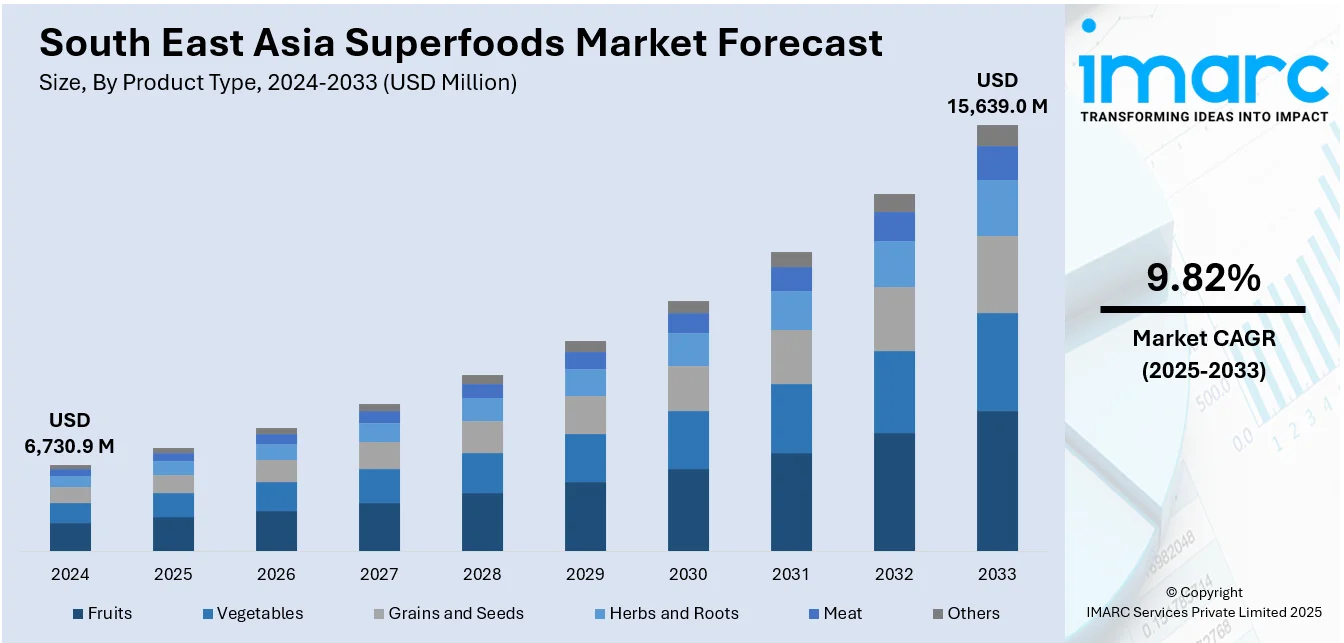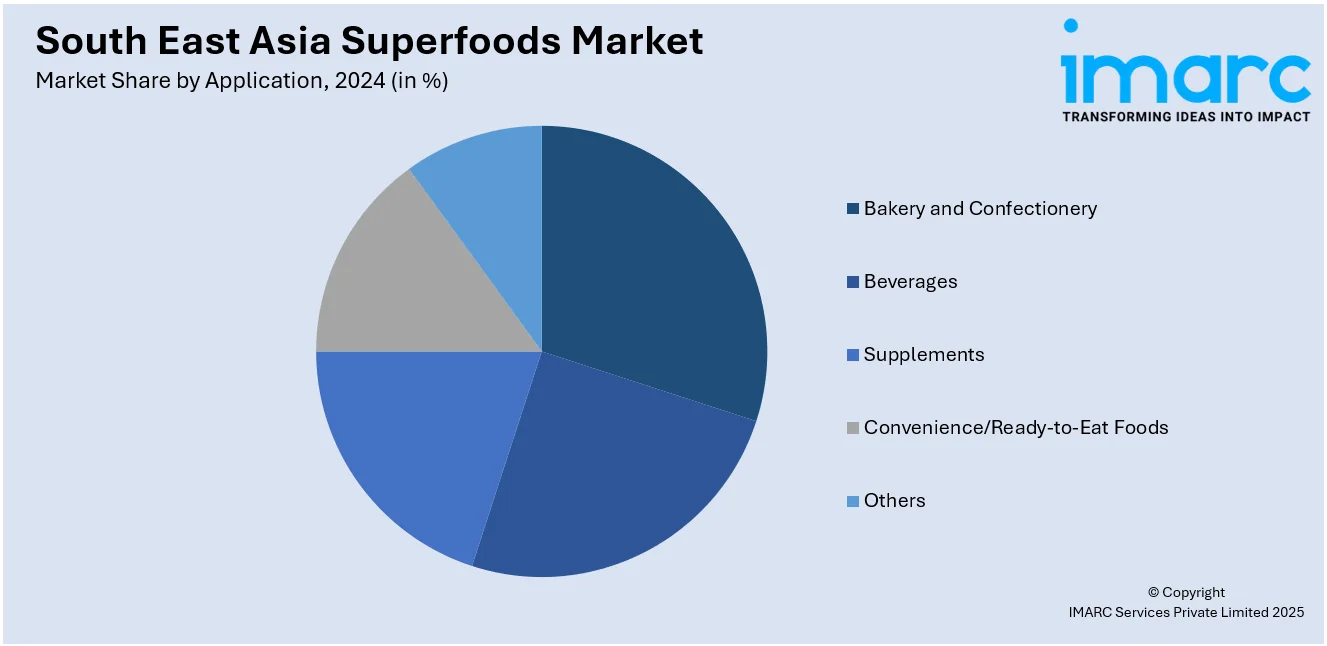
South East Asia Superfoods Market Report by Product Type (Fruits, Vegetables, Grains and Seeds, Herbs and Roots, Meat, and Others), Application (Bakery and Confectionery, Beverages, Supplements, Convenience/Ready-to-Eat Foods, and Others), Distribution Channel (Supermarkets and Hypermarkets, Convenience Stores, Specialty Stores, Independent Small Grocery Stores, Online Sales, and Others), and Country 2025-2033
Market Overview:
South East Asia superfoods market size reached USD 6,730.9 Million in 2024. Looking forward, IMARC Group expects the market to reach USD 15,639.0 Million by 2033, exhibiting a growth rate (CAGR) of 9.82% during 2025-2033. The expanding distribution channels, including online retail platforms, supermarkets, health food stores, and specialized organic markets, which has made superfoods more accessible to a wider consumer base, is driving the market.
|
Report Attribute
|
Key Statistics
|
|---|---|
|
Base Year
|
2024
|
|
Forecast Years
|
2025-2033
|
|
Historical Years
|
2019-2024
|
|
Market Size in 2024
|
USD 6,730.9 Million |
|
Market Forecast in 2033
|
USD 15,639.0 Million |
| Market Growth Rate 2025-2033 | 9.82% |
Superfoods refer to nutrient-rich foods that are believed to provide numerous health benefits. These foods are typically packed with vitamins, minerals, and antioxidants and are often associated with reducing the risk of chronic diseases, improving overall well-being, and promoting longevity. Some well-known superfoods include berries, such as blueberries and acai berries, which are rich in antioxidants and may help combat inflammation and promote heart health. Leafy greens like spinach and kale are also considered superfoods owing to their high nutrient content, including vitamins A, C, and K, as well as various minerals. Other examples include fatty fish like salmon, which is an excellent source of omega-3 fatty acids that are known for supporting heart health and brain function. Additionally, nuts and seeds, such as almonds and chia seeds, are often classified as superfoods due to their high protein, fiber, and healthy fat content, which may contribute to improved energy levels and weight management.

To get more information on this market, Request Sample
South East Asia Superfoods Market Trends:
The superfoods market in South East Asia has experienced a remarkable surge in recent years, driven primarily by the increasing health consciousness among consumers. To begin with, the escalating prevalence of chronic diseases has prompted individuals to adopt healthier dietary habits. Consequently, there has been a notable shift towards the consumption of nutrient-dense superfoods, which are renowned for their rich antioxidant properties and potential disease-fighting capabilities. Furthermore, the rising disposable income levels in emerging economies have contributed significantly to the expansion of the superfoods market. As a result, consumers are more willing to invest in premium products that offer enhanced nutritional benefits, thereby propelling the demand for superfoods across various demographic segments. Additionally, the growing influence of social media and digital platforms has played a pivotal role in shaping consumer preferences fostering greater awareness about the health benefits associated with superfoods. Moreover, the burgeoning trend of clean eating and organic food consumption, as health-conscious consumers prioritize natural and unprocessed dietary choices, is expected to drive the superfoods market in South East Asia during the forecast period.
South East Asia Superfoods Market Segmentation:
IMARC Group provides an analysis of the key trends in each segment of the market, along with forecasts at the regional and country levels for 2025-2033. Our report has categorized the market based on product type, application, and distribution channel.
Product Type Insights:
- Fruits
- Vegetables
- Grains and Seeds
- Herbs and Roots
- Meat
- Others
The report has provided a detailed breakup and analysis of the market based on the product type. This includes fruits, vegetables, grains and seeds, herbs and roots, meat, and others.
Application Insights:

- Bakery and Confectionery
- Beverages
- Supplements
- Convenience/Ready-to-Eat Foods
- Others
A detailed breakup and analysis of the market based on the application have also been provided in the report. This includes bakery and confectionery, beverages, supplements, convenience/ready-to-eat foods, and others.
Distribution Channel Insights:
- Supermarkets and Hypermarkets
- Convenience Stores
- Specialty Stores
- Independent Small Grocery Stores
- Online Sales
- Others
The report has provided a detailed breakup and analysis of the market based on the distribution channel. This includes supermarkets and hypermarkets, convenience stores, specialty stores, independent small grocery stores, online sales, and others.
Country Insights:
- Indonesia
- Thailand
- Singapore
- Philippines
- Vietnam
- Malaysia
- Others
The report has also provided a comprehensive analysis of all the major regional markets, which include Indonesia, Thailand, Singapore, Philippines, Vietnam, Malaysia, and Others.
Competitive Landscape:
The market research report has also provided a comprehensive analysis of the competitive landscape in the market. Competitive analysis such as market structure, key player positioning, top winning strategies, competitive dashboard, and company evaluation quadrant has been covered in the report. Also, detailed profiles of all major companies have been provided.
South East Asia Superfoods Market Report Coverage:
| Report Features | Details |
|---|---|
| Base Year of the Analysis | 2024 |
| Historical Period | 2019-2024 |
| Forecast Period | 2025-2033 |
| Units | Million USD |
| Scope of the Report | Exploration of Historical and Forecast Trends, Industry Catalysts and Challenges, Segment-Wise Historical and Predictive Market Assessment:
|
| Product Types Covered | Fruits, Vegetables, Grains and Seeds, Herbs and Roots, Meat, Others |
| Applications Covered | Bakery and Confectionery, Beverages, Supplements, Convenience/Ready-to-Eat Foods, Others |
| Distribution Channels Covered | Supermarkets and Hypermarkets, Convenience Stores, Specialty Stores, Independent Small Grocery Stores, Online Sales, Others |
| Countries Covered | Indonesia, Thailand, Singapore, Philippines, Vietnam, Malaysia, Others |
| Customization Scope | 10% Free Customization |
| Post-Sale Analyst Support | 10-12 Weeks |
| Delivery Format | PDF and Excel through Email (We can also provide the editable version of the report in PPT/Word format on special request) |
Key Questions Answered in This Report:
- How has the South East Asia superfoods market performed so far and how will it perform in the coming years?
- What is the breakup of the South East Asia superfoods market on the basis of product type?
- What is the breakup of the South East Asia superfoods market on the basis of application?
- What is the breakup of the South East Asia superfoods market on the basis of distribution channel?
- What are the various stages in the value chain of the South East Asia superfoods market?
- What are the key driving factors and challenges in the South East Asia superfoods?
- What is the structure of the South East Asia superfoods market and who are the key players?
- What is the degree of competition in the South East Asia superfoods market?
Key Benefits for Stakeholders:
- IMARC’s industry report offers a comprehensive quantitative analysis of various market segments, historical and current market trends, market forecasts, and dynamics of the South East Asia superfoods market from 2019-2033.
- The research report provides the latest information on the market drivers, challenges, and opportunities in the South East Asia superfoods market.
- Porter's five forces analysis assist stakeholders in assessing the impact of new entrants, competitive rivalry, supplier power, buyer power, and the threat of substitution. It helps stakeholders to analyze the level of competition within the South East Asia superfoods industry and its attractiveness.
- Competitive landscape allows stakeholders to understand their competitive environment and provides an insight into the current positions of key players in the market.
Need more help?
- Speak to our experienced analysts for insights on the current market scenarios.
- Include additional segments and countries to customize the report as per your requirement.
- Gain an unparalleled competitive advantage in your domain by understanding how to utilize the report and positively impacting your operations and revenue.
- For further assistance, please connect with our analysts.
 Request Customization
Request Customization
 Speak to an Analyst
Speak to an Analyst
 Request Brochure
Request Brochure
 Inquire Before Buying
Inquire Before Buying




.webp)




.webp)












